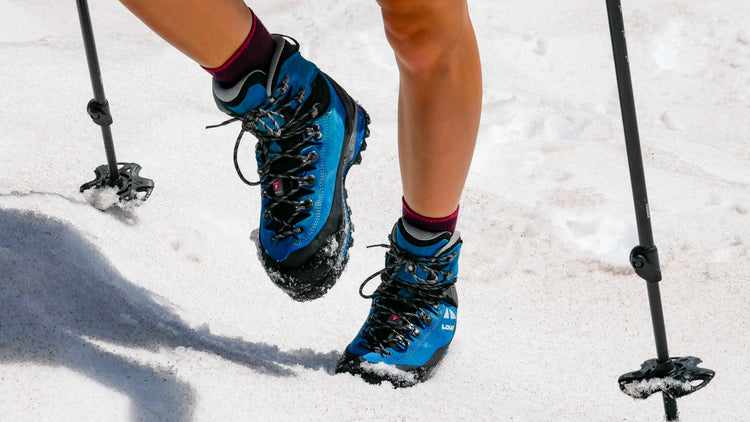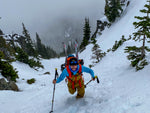With early-season climbing in full swing on Mount Rainier, we figured it was time to revisit one of the most common questions we get here at Whittaker Mountaineering; how do I choose a mountaineering boot? With dozens of different styles tailored to almost every situation you can encounter in the mountains, saying it’s hard to choose is an understatement. Hopefully, this blog helps with your understanding of mountaineering boots, but if you want a more in-depth look at mountaineering footwear in general, check out our Mountain Logic™ Footwear Guide.
Types of Boots
To start, we’ll take a look at different types of mountaineering boots, from general boots that will cover 85% of your use cases, to extreme boots tailored to specific alpine situations. For this post, we’ll be looking only at true mountaineering boots, so 3-season hiking boots are out.
Single Boots
If you’re looking for a general mountaineering boot, this is probably the way to go. Single boots are made from leather or synthetic materials and are the most similar to your standard hiking boot. While their features may vary from brand to brand, there are a few things you should always look for in a single boot:
- A rigid, crampon-compatible sole, with a “ledge” at the heel to allow for clip crampons.
- Insulation, while these won’t be the warmest boots out there, they should have at least some insulation.
- At least some water-proofing, usually a Gore-Tex coating.
You’ll find that a single boot is great for any “warm” weather mountaineering, like a mid-season Rainier or Cotopaxi climb. For more info on single boots, check out some of our favorites; Lowa Alpine Expert GTX (for a comfortable fit and great performance), La Sportiva Nepal Cube GTX (for a narrower foot, also a Guide Pick™ favorite), or the Lowa Alpine SL GTX (a lighter boot more akin to regular hiking boots).
Double Boots
For climbs where temps will be lower or any kind of winter climbing, consider a double boot. Double boots consist of an inner and outer boot, occasionally with a built-in gaiter. While double boots used to use either a leather or plastic outer boot, leather is now much more common, with plastic double boots only found in rental programs. Besides being warmer than single boots, double boots can also reduce blisters and hot spots, as the friction created when you walk is between the inner and outer boot, as opposed to your foot and the single-layer boot. That being said, double boots will be a bit stiffer and clunkier, and add a bit more weight to each foot.
When looking for a double boot, be sure to keep an eye out for all the key features you’d look for in a single boot, plus an insulated, removable liner. If it doesn’t have a liner, it’s not a double boot! For more info on double boots, check out the La Sportiva G2 Evo for a narrower fit, or the Lowa Expedition 6000 Evo RD or Scarpa Phantom 6000 for a slightly wider fit.
High Alpine Boots
As we said, the above styles of boots will cover most of your mountaineering needs. But for those truly cold missions to the highest places on earth, your feet need a little something extra to keep them warm and protected. Enter the high alpine class of mountaineering boots. Used on Denali, Everest, Aconcagua, and in other extreme conditions, these boots have significantly more insulation and at least two layers of boot. These will almost always have a built-in gaiter for added warmth, and often utilize Boa tightening systems that are easier to use with bulky gloves than traditional lacing.
We’re big fans of Lowa here at Whittaker Mountaineering, and the Lowa Expedition 8000 Evo RD are some of our favorite high-altitude boots.
Boot Fitting Tips
Once you’ve figured out the kind of boot you need for your expedition, it’s time to find the right size. Below, we’ve spelled out our boot fitting recipe for success, but if you want more tip, check out our extensive guide here!
How a boot fits is without question the most important factor of boot selection. While trekking boots and hiking shoes should fit the same as your street shoes, general and high alpine mountaineering boots fit a little differently. A good fit correctly addresses the three dimensions of your foot:
Length - Toes should wiggle easily inside the footwear. If you have hammertoes or some kind of toe sensitivity such as a neuroma, pay special attention to choosing a boot with the right length (depth) for your foot. We suggest sizing up one half to a full size from your regular street shoes for mountaineering boots.
Width - Feet should not slide around inside footwear; nor should they be compressed from side to side.
Volume - The "bulk" of your foot should fit securely inside a boot’s interior. Matching the volume of a boot to your foot is the most critical part of getting a good fit. It has everything to do with controlling heel slip (blisters) and toe bang on downhill hiking (black toenails). When a boot fits properly it should feel like a big hand is holding your foot over the instep where the laces are. Your foot should feel very “quiet” in the boot as you walk.
No matter what kind of boot you decide to go with, be sure to get plenty of steps in before setting off on your expedition. Once you’re on the mountain, you’re stuck with your boots, and your feet will thank you for breaking them in beforehand!
Want to tell us your favorite boot or ask questions about which boot you should be using? Comment below and we'll get back to you!
As always,
Happy Climbing!








